Hui people: Difference between revisions
m robot Adding: os:Хуэйаг адæм |
→Republican era: cap. |
||
| Line 89: | Line 89: | ||
===Republican era=== |
===Republican era=== |
||
The population has been repressed in terms of the freedom of religion and cultural assimilation under the regime of Chinese communist party. Over the years, there have been numerous different scale of clashes happened all over the Hui communities. Most of the incidents brutally ended with being repressed by |
The population has been repressed in terms of the freedom of religion and cultural assimilation under the regime of Chinese communist party. Over the years, there have been numerous different scale of clashes happened all over the Hui communities. Most of the incidents brutally ended with being repressed by Chinese state police as illegal. Mosques have also been closely monitored by the Chinese secret police. |
||
===Panthays=== |
===Panthays=== |
||
Revision as of 07:17, 1 March 2010
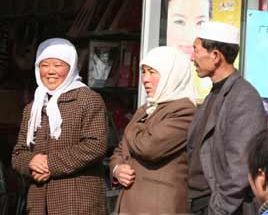 Hui people | |
| Regions with significant populations | |
|---|---|
| Languages | |
| Chinese languages | |
| Religion | |
| Islam | |
| Related ethnic groups | |
| Dungan, Panthay, Han Chinese, other Sino-Tibetan peoples |
| Hui people | |||||||||||||
|---|---|---|---|---|---|---|---|---|---|---|---|---|---|
| Chinese name | |||||||||||||
| Chinese | 回族 | ||||||||||||
| |||||||||||||
| Dunganese name | |||||||||||||
| Dungan | Хуэйзў | ||||||||||||
| Xiao'erjing | حُوِ ذَو | ||||||||||||
| Romanization | Huejzw | ||||||||||||
| Russian name | |||||||||||||
| Russian | Дунгане | ||||||||||||
The Hui people (Chinese: 回族; pinyin: Huízú, Xiao'erjing: حُوِ ذَو ) are a Chinese ethnic group, typically distinguished by their practice of Islam.
In modern People's Republic of China, the term "Hui people" refers to one of the officially recognized 56 ethnic groups into which Chinese citizens are classified. Under this definition, the Hui people are defined to include all historically Muslim communities in People's Republic of China that are not included in China's other ethnic groups.[2] Since China's Muslims speaking various Turkic, Mongolian, or Iranian languages are all included into those other groups (e.g., Uyghurs, Tajiks, or Dongxiang), the "officially recognized" Hui ethnic group consists predominantly of Chinese speakers.[3] In fact, the "Hui nationality" is unique among China's officially recognized ethnic minorities in that it does not have any particular non-Chinese language associated with it.[4]
Nonetheless, included among the Hui in Chinese census statistics (and not officially recognized as separate ethnic groups) are members of a few small non-Chinese speaking communities. Among them are several thousand Utsuls in southern Hainan province, who speak an Austronesian language (Tsat) related to that of the Cham Muslim minority of Vietnam, and who are said to be descended from Chams who migrated to Hainan.[5] A small Muslim minority among Yunnan's Bai people are classified as Hui as well (even if they are Bai speakers),[6] as are some groups of Tibetan Muslims.[5]
The Hui people are concentrated in Northwestern China (Ningxia, Gansu, Qinghai, Xinjiang), but communities exist across the country, e.g. Beijing, Inner Mongolia, Hebei, Yunnan, etc.
Most Hui are similar in culture to Han Chinese with the exception that they practice Islam, and have some distinctive cultural characteristics as a result. For example, as Muslims, they follow Islamic dietary laws and reject the consumption of pork, the most common meat consumed in Chinese culture,[7] and have also given rise to their variation of Chinese cuisine, Chinese Islamic cuisine and Muslim Chinese martial arts. Their mode of dress also differs primarily in that men wear white caps and women wear headscarves or (occasionally) veils, as is the case in most Islamic cultures.
The Hui people are mixed blood. Their ancestors include Central Asian, Persian, Han Chinese, and Mongols. In ancient China, e.g. Tang and Yuan Dynasty, lots of people from Central Asian and Persia came to trade or pursue political careers. In the following nearly one thousand years, they gradually mixed with Mongols and Han Chinese, and the Hui people were formed. Because the Hui people have lived in China for so many years, they haven't retained Arabic and Central Asian languages, instead becoming Chinese speakers.
Apart from some minor characteristics, the majority of Hui people look much like Han Chinese, especially in eastern China.
Etymology
"Huihui" and "Hui"

The name of the today's Hui people (i.e., Chinese speaking Muslims) has a long history, although throughout much of it it may have referred to people who either were not Muslim, or non-Chinese speakers.
The word Huihui (回回), which was the usual generic term for China's Muslims during the Ming and Qing Dynasties, is thought to have its origin in the earlier Huihe (回纥) or Huihu (回纥), which was the name for the Uyghur State of the 8th and 9th century.[8] Although the ancient Uyghurs were neither Muslims nor were very directly related to today's Uyghur people,[8] the name Huihui came to refer to all Muslims, regardless of language or origin, by the time of the Yuan (1271–1368) [9] and Ming Dynasties (1368–1644).[8]
Another, probably unrelated, early use of the word Huihui comes from the History of Liao Dyansty, which mentions Yelü Dashi, the 12th-century founder of the Kara-Khitan Khanate, defeating the Huihui Dashibu (回回大食部) people near Samarkand - apparently, referring to his defeat of the Khwarazm ruler Ahmed Sanjar in 1141.[10] Khwarazm is referred to as Huihuiguo in the Secret History of the Mongols as well.[11]
The widespread and rather generic application of the name "Huihui" in Ming China was attested by foreign visitors as well. Matteo Ricci, the first Jesuit to reach Beijing (1598), noted that "Saracens are everywhere in evidence... their thousands of families are scattered about in nearly every province"[12] Ricci noted that the term Huihui or Hui was applied by Chinese not only to "Saracens" (Muslims) but also to Chinese Jews and supposedly even to Christians.[13] In fact, when the reclusive Wanli Emperor first saw a picture of Ricci and Diego de Pantoja, he supposedly exclaimed, "Hoei, hoei. It is quite evident that they are Saracens", and had to be told by a eunuch that they actually weren't, "because they ate pork".[14]
While Huihui or Hui remained a generic name for all Muslims in Imperial China, specific terms were sometimes used to refer to particular groups - e.g. Chantou Hui ("turbaned Hui") for Uyghurs, Dongxiang Hui and Sala Hui for Dongxiang and Salar people, and sometimes even Han Hui ("Chinese Hui") for the (presumably Chinese-speaking) Muslims more assimilated into the Chinese mainstream society.[15]
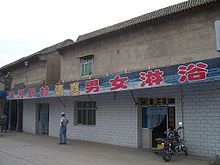
Under the aegis of the Communist Party in the 1930s the term Hui was defined to indicate only Sinophone Muslims. In 1941, this was clarified by a Communist Party committee comprising ethnic policy researchers in a treatise entitled "On the question of Huihui Ethnicity" (Huihui minzu wenti). This treatise defined the characteristics of the Hui nationality as follows: the Hui or Huihui constitute an ethnic group associated with, but not defined by, the Islamic religion and they are descended primarily from Muslims who migrated to China during the Mongol-founded Yuan dynasty (1271–1368), as distinct from the Uyghur and other Turkic-speaking ethnic groups in Xinjiang. The Nationalist government had recognised all Muslims as one of "the five peoples"—alongside the Manchus, Mongols, Tibetans and Han Chinese—that constituted the Republic of China. The new Communist interpretation of Chinese Muslim ethnicity marked a clear departure from the ethno-religious policies of the Nationalists, and had emerged as a result of the pragmatic application of Stalinist ethnic theory to the conditions of the Chinese revolution.[16]
These days, within the PRC, Huizu and is the standard term for the "Hui nationality" (ethnic group), and Huimin , for "Hui people" or "a Hui person". The traditional expression Huihui, its use now largely restricted to rural areas, would sound quaint, if not outright demeaning, to modern urban Chinese Muslims.[17]
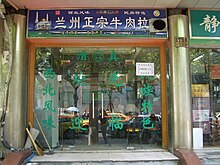
A traditional Chinese term for Islam is 回教 (pinyin: Huíjiào, literally "the religion of the Hui"). However, since the early days of the PRC, thanks to the arguments of such Marxist Hui scholars as Bai Shouyi, the standard term for "Islam" within the PRC has become the transliteration 伊斯蘭教 (pinyin: 'Yīsīlán jiào, literally "Islam religion").[18] The more traditional term Huijiao remains in use in Singapore, Taiwan, and other overseas Chinese communities.[19]
Qīngzhēn (清真, literally "pure and true") has also been a popular term for the things Muslim since the Yuan or Ming Dynasty. Dru Gladney suggests that a good translation for it would be Arabic tahára. i.e. "ritual or moral purity"[20] The usual term for a mosque is qīngzhēn sì (清真寺), i.e. "true and pure temple", and qīngzhēn is commonly used to refer to halal eating establishments and bathhouses.
"Dungan"
Hui people everywhere are referred to by Central Asian Turkic speakers and Tajiks as Dungans. This term has a long pedigree as well. The region's historian Joseph Fletcher cites Turkic and Persian manuscripts related to the preaching of the 17th century Kashgarian Sufi master Muhammad Yūsuf (or, possibly, his son Afaq Khoja) inside the Ming Empire (in today's Gansu and/or Qinghai), where the Kashgarian preacher is told to have converted 'ulamā-yi Tunganiyyān (i.e., "Dungan ulema") into Sufism.[21]
In English and German, the ethnonym "Dungan", in various spelling forms, was attested as early as 1830s, typically referring to the Hui people of Xinjiang. For example, James Prinsep in 1835 mentions Muslim "Túngánis" in "Chinese Tartary".[22] The word (mostly in the form "Dungani" or "Tungani", sometimes "Dungens" or "Dungans") acquired some currency in English and other western languages when a number of books in the 1860-70s discussed the Dungan revolt in north-western China.
Later authors continued to use the term Dungan (in various transcriptions) for, specifically, the Hui people of Xinjiang. For example, Owen Lattimore, writing ca. 1940, maintains the terminological distinction between these two related groups: the "T'ungkan" (i.e. Wade-Giles for "Dungan"), described by him as the descendants of the Gansu Hui people resettled in Xinjiang in 17-18th centuries, vs. e.g. the "Gansu Moslems" or generic "Chinese Moslems".[23]
In Russian Empire, the Soviet Union, and its successor countries, the term "Dungans" (дунгане) became the standard name for the descendants of Chinese-speaking Muslims who emigrated to Russian Empire (mostly, today's Kyrgyzstan and south-eastern Kazakhstan in the 1870s and 1880s).[24]
Other terms
In Thailand Chinese Muslims are referred to as Chin Ho, in Myanmar and Yunnan Province, as Panthay.
History
Origins
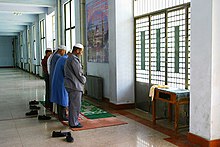
The Hui Chinese have diverse origins. Some in the southeast coast (Guangdong, Fujian) and in major trade centers elsewhere in China are of mixed local and foreign descent. The foreign element, although greatly diluted, came from Arab (Dashi) and Persian (Bosi) traders, who brought Islam to China. These foreigners settled in China and gradually intermarried into the surrounding population while converting them to Islam, while they in turn assimilated in all aspects of Chinese culture, keeping only their distinctive religion.[25]
A totally different explanation is available for the Hui people of Yunnan and Northwestern China, whose ethnogenesis might be a result of the convergence of large number of Mongol, Turkic, Iranian or other Central Asian settlers in these regions, who were recruited by the Mongol-founded Yuan Dynasty either as officials (the semu, who formed the second-highest stratum in the Yuan Empire's ethnic hierarchy, after the Mongols themselves, but before both northern and southern Chinese) or artisans.[26][27] It was documented that a proportion of the ancestral nomad or military ethnic groups were originally Nestorian Christians many of whom later converted to Islam, while under the Sinicizing pressures of the Ming and Qing states.
To these days, many Hui people and non-Hui observers say that facial features of some members of their communities make them somewhat distinct from the surrounding Han population, and reflect their Southwest Asian ancestry.[28]
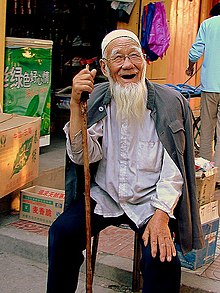
Southeastern Muslims also have a much longer tradition of synthesizing Confucian teachings with the Sharia and Qur'anic teachings, and were reported to have been contributing to the Confucian officialdom since the Tang period. Among the Northern Hui, on the other hand, there are strong influences of Central Asian Sufi schools such as Kubrawiyya, Qadiriyya, Naqshbandiyya (Khufiyya and Jahriyya) etc. mostly of the Hanafi Madhhab (whereas among the Southeastern communities the Shafi'i Madhhab is more of the norm). Before the "Ihwani" movement, a Chinese variant of the Salafi movement, Northern Hui Sufis were very fond of synthesizing Taoist teachings and martial arts practices with Sufi philosophy.
In early modern times, villages in Northern Chinese Hui areas still bore labels like "Blue-cap Huihui," "Black-cap Huihui," and "White-cap Huihui," betraying their possible Christian, Judaic and Muslim origins, even though the religious practices among North China Hui by then were by and large Islamic. Hui is also used as a catch-all grouping for Islamic Chinese who are not classified under another ethnic group.
Muslim Revolts
During the mid-nineteenth century, a series of civil wars broke out throughout China by various ethnic-lingual groups against the ruling Manchu-Mongol-Han Bannerman and Han Confucians elites. These include the Taiping Rebellion in Southern China (whose leaders were Evangelical Christians of ethnic Han Chinese Hakka and Zhuang background), the Muslims Rebellion in Shaanxi, Gansu, Qinghai and Ningxia in Northwestern China and Yuannan, and the Miao people Revolt in Hunan and Guizhou. These revolts were supported by European Powers at the beginning but eventually put down by the Manchu government. The Dungan people were descendants of the Muslim rebels who fled to Russian Empire after the rebellion were suppressed by the joint force of Hunan Army led by Zuo Zongtang (左宗棠) with support from local Hui elites.
Population loss during these revolts was staggering. Some have estimated that the population loss in Shaanxi between 1862 and 1879 was as high as 6,220,000, about 44.6% of the original population before the war, of which 5.2 million was due to war. For the Hui, the figure may have been as high as 1.55 million. In 1990, there were only 132,000 Hui in Shaanxi.[29]
Republican era
The population has been repressed in terms of the freedom of religion and cultural assimilation under the regime of Chinese communist party. Over the years, there have been numerous different scale of clashes happened all over the Hui communities. Most of the incidents brutally ended with being repressed by Chinese state police as illegal. Mosques have also been closely monitored by the Chinese secret police.
Panthays
Panthays form a group of Chinese Muslims in Burma. Some people refer to Panthays as the oldest group of Chinese Muslims in Burma. However, because of intermixing and cultural diffusion the Panthays are not as distinct a group as there once were.
Dungans
Dungan (simplified Chinese: 东干族; traditional Chinese: 東干族; pinyin: Dōnggānzú; Russian: Дунгане) is a term used in territories of the former Soviet Union and in Xinjiang to refer to Chinese-speaking Muslim people. In the censuses of Russia and the former Soviet Central Asia, the Hui are enumerated separately from Chinese, and are labelled as Dungans. In both China and the former Soviet republics where they reside, however, members of this ethnic group call themselves Lao Huihui or Zhongyuanren, not Dungans. Zhongyuan 中原, literally means "The Central Plain" is the historical name of Shaanxi and Henan provinces. Most Dungans living in former Soviet Union are descendants of Hui people from Gansu and Shaanxi.
1940s and after
Hui fought against the Japanese in World War II and had formed 'Hui Brigades'.[30] The Shadian incident also took place in 1975.
Surnames
Hui people commonly believe that their surnames originated as "Sinified" forms of their foreign Muslim ancestors some time during the Yuan or Ming eras.[31] These are some common surnames used by the Hui ethnic group:[citation needed]
- Ma for Muhammad
- Mu for Muhammad[32]
- Han for Muhammad
- Ha for Hasan
- Hu for Hussein
- Sai for Said
- Sha for Shah
- Zheng for Shams
- Koay for Kamaruddin
- Chuah for Osman
A legend in Ningxia states that four Hui surnames common in the region - Na, Su, La, and Ding - originate with the descendants of one Nasruddin, a son of Sayyid Ajjal Shams al-Din Omar, who "divided" the ancestor's name (Nasulading, in Chinese) among themselves.[33]
Prominent Hui
- Bai Chongxi (白崇禧), a general of the Republic of China
- Bai Shouyi (白壽彝), prominent Chinese historian and ethnologist
- Hai Feng (海峰), a professor of Xinjiang University and an author of a book on Dungan language
- Hui Liangyu (回良玉), a Vice Premier of the People's Republic of China
- Lan Yu was a Ming Dynasty general who ended the Mongol dream to reconquer China.
- Li Zhi (李贄), a famous Confucian philosopher in Ming Dynasty, would perhaps be considered a Hui if he lived today because of some his ancestors being Persian Muslims.
- Ma Dexin (马德新), Islamic scholar in Yunnan
- Ma Bufang ( 馬步芳), was a warlord in China during the Republic of China era, ruling the northwestern province of Qinghai.
- Ma Hualong (马化龙), one of the leaders of the Muslim Rebellion of 1862-77.
- Shi Zhongxin, mayor of Harbin from 2002 to February 2007, whose ancestors came from Jilin
- Zhang Chengzhi (張承志), contemporary author and alleged creator of the term "Red Guards"
- Zheng He (鄭和), a Semu Muslim, probably the most famous Muslim in Chinese history, would perhaps be considered a Hui if he lived today
Related group names
- Dungan (in Kyrgyzstan, Kazakhstan)
- Panthay (in Burma)
- Utsul (in Hainan Island; speakers of a Malayo-Polynesian language, but officially classified by the Chinese government as Hui)
See also
Further reading
- Chuah, Osman (2004). "Muslims in China: the social and economic situation of the Hui Chinese". Journal of Muslim Minority Affairs. 24 (1): 155–162. doi:10.1080/1360200042000212133.
{{cite journal}}: Cite has empty unknown parameters:|laydate=,|laysource=,|quotes=,|laysummary=, and|coauthors=(help); Unknown parameter|month=ignored (help)
Footnotes
| Part of a series on Islam in China |
|---|
 |
|
|
- ^ China - The Hui Ethnic Group
- ^ Lipman (1997), p. xxiii, or Gladney (1996), pp. 18-20. Besides the Hui people, nine other officially recognized ethnic groups of PRC are considered predominantly Muslim. Those nine groups are defined mainly on linguistic grounds: namely, six groups speaking Turkic languages ( Uyghurs, Kazakhs, Kyrgyz, Salars, Uzbeks, and Tatars), two Mongolian-speaking groups (Dongxiang and Bonan), and one Iranian-speaking group (Tajiks).
- ^ Gladney (1996), p. 20.
- ^ Of course, many members of some other Chinese ethnic minorities don't speak their ethnic group's traditional language anymore, and practically no Manchu people speak the Manchu language natively anymore; but even the Manchu language is well attested historically. Meanwhile the ancestors of today's Hui people are thought to have been predominantly native Chinese speakers since no later than the mid- or early Ming Dynasty (Lipman (1997), p. 50
- ^ a b Gladney (1996), pp. 33-34
- ^ Gladney (1996), pp. 33-34. The Bai-speaking Hui typically claim descent of Hui refugees who fled to Bai areas after the defeat of the Panthay Rebellion, and have assimilated to the Bai culture since
- ^ Gladney (1996), p. 13. Quote: "In China, pork has been the basic meat protein for centuries and regarded by Chairman Mao as 'a national treasure'"
- ^ a b c Gladney (1996), p.18; or Lipman (1997), pp. xxiii-xxiv
- ^ Gladney (2004), p. 161; he refers to Leslie (1986), pp. 195-196
- ^ Dillon (1999), p. 13
- ^ Dillon (1999), p. 15
- ^ Trigault, Nicolas S. J. "China in the Sixteenth Century: The Journals of Mathew Ricci: 1583-1610". English translation by Louis J. Gallagher, S.J. (New York: Random House, Inc. 1953). This is an English translation of the Latin work, De Christiana expeditione apud Sinas based on Matteo Ricci's journals completed by Nicolas Trigault. Pp. 106-107. There is also full Latin text available on Google Books.
- ^ Trigault (trans.) (1953), p. 112. In Samuel Purchas's translation (1625) (Vol. XII, p. 466): "All these Sects the Chinois call, Hoei, the Jewes distinguished by their refusing to eate the sinew or leg; the Saracens, Swines flesh; the Christians, by refusing to feed on round-hoofed beasts, Asses, Horses, Mules, which all both Chinois, Saracens and Jewes doe there feed on." It's not entirely clear what Ricci means by saying that Hui also applied to Christians, as he does not report finding any actual local Christians.
- ^ Trigault (trans.) (1953), p. 375
- ^ Gladney (1996), p. 18; Lipman (1997), p. xxiii
- ^ China Heritage Newsletter
- ^ Gladney (1996), pp. 20-21
- ^ Gladney (1996), pp. 18-19, or Gladney (2004), pp. 161-162
- ^ On the continuing use of Huijiao in Taiwan, see Gladney (1996), pp. 18-19
- ^ Gladney (1996), pp. 12-13
- ^ Lipman (1997), p. 59, based on: Joseph Fletcher, "The Naqshbandiya in Northwest China", in Beatrcie Manz, ed. (1995). Studies on Chinese and Islamic Inner Asia. London: Variorum.
- ^ James Prinsep, "Memoir on Chinese Tartary and Khoten". The Journal of the Asiatic Society of Bengal, No. 48, December 1835. P. 655.On Google Books. Prinsep's article is also available in "The Chinese Repository", 1843, p. 234 On Google Books. A modern (2003) reprint is available, ISBN 1402156316.
- ^ Owen Lattimore, Inner Asian Frontiers of China. Page 183 in the 1951 edition.
- ^ Gladney (1996), pp. 33, 399
- ^ Lipman 1997, p. 24-31
- ^ Lipman 1997, p. 31-35
- ^ Dillon 1999, p. 19-21
- ^ Gladney (1996), pp. 23-24
- ^ 路伟东 (8 Nov 2005). "In Chinese:同治光绪年间陕西人口的损失(Population loss in Shanxi between 1862–1879)". Retrieved 2008-12-14.
- ^ [1]
- ^ Gladney (1996), p. 250
- ^ Dillon (1999), p. 33
- ^ Dillon (1999), p. 22
References
- Dillon, Michael (1999), China's Muslim Hui community: migration, settlement and sects, Routledge, ISBN 0700710264
- Dru C. Gladney, "Ethnic Identity in China: The Making of a Muslim Minority Nationality (Case Studies in Cultural Anthropology)", 1997, ISBN 0155019708.
- Gladney, Dru C. (1996), Muslim Chinese: Ethnic Nationalism in the People's Republic (2 ed.), ISBN 0-674-59497-5 (1st edition appeared in 1991)
- Gladney, Dru C. (2004), Dislocating China: reflections on Muslims, minorities and other subaltern subjects, C. Hurst & Co. Publishers, ISBN 1850653240
- Leslie, Donald (1986), Islam in traditional China: a short history to 1800, Canberra College of Advanced Education
- Lipman, Jonathan Neaman (1997), Familiar strangers: a history of Muslims in Northwest China, University of Washington Press, ISBN 9622094686
- "CHINA'S ISLAMIC HERITAGE" China Heritage Newsletter (Australian National University), No. 5, March 2006.
